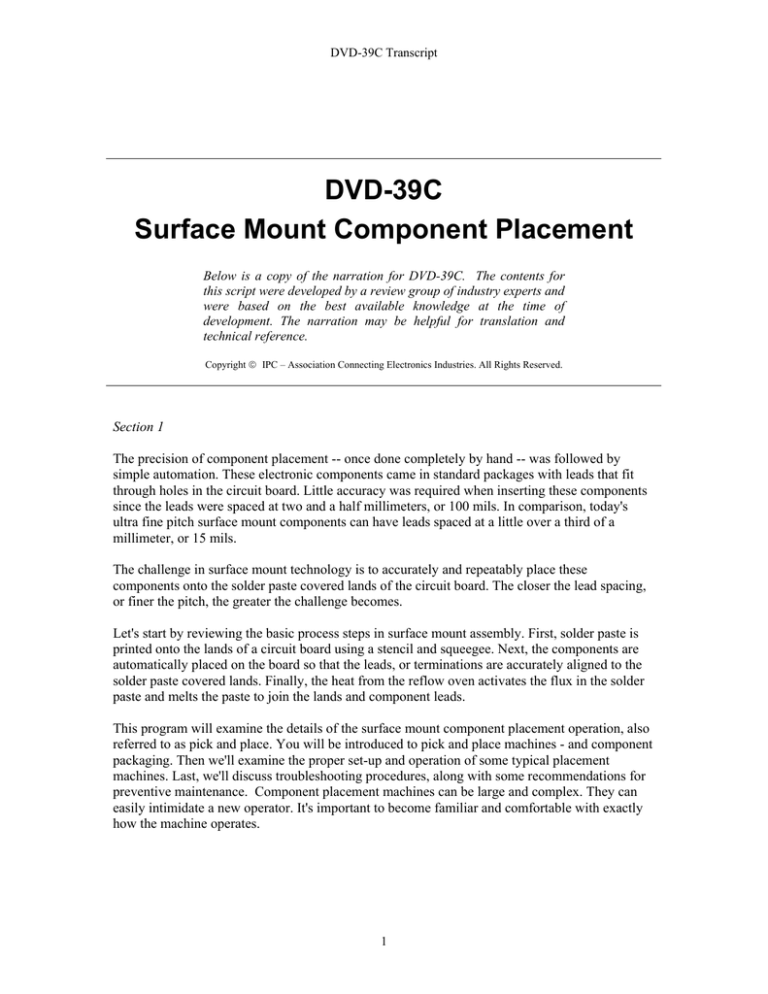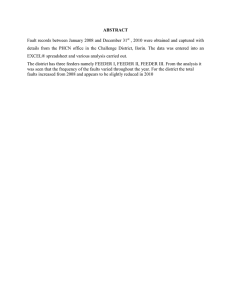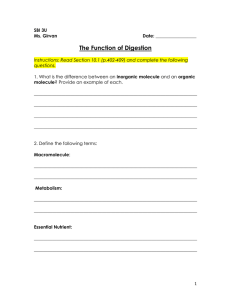
DVD-39C Transcript
DVD-39C
Surface Mount Component Placement
Below is a copy of the narration for DVD-39C. The contents for
this script were developed by a review group of industry experts and
were based on the best available knowledge at the time of
development. The narration may be helpful for translation and
technical reference.
Copyright © IPC – Association Connecting Electronics Industries. All Rights Reserved.
Section 1
The precision of component placement -- once done completely by hand -- was followed by
simple automation. These electronic components came in standard packages with leads that fit
through holes in the circuit board. Little accuracy was required when inserting these components
since the leads were spaced at two and a half millimeters, or 100 mils. In comparison, today's
ultra fine pitch surface mount components can have leads spaced at a little over a third of a
millimeter, or 15 mils.
The challenge in surface mount technology is to accurately and repeatably place these
components onto the solder paste covered lands of the circuit board. The closer the lead spacing,
or finer the pitch, the greater the challenge becomes.
Let's start by reviewing the basic process steps in surface mount assembly. First, solder paste is
printed onto the lands of a circuit board using a stencil and squeegee. Next, the components are
automatically placed on the board so that the leads, or terminations are accurately aligned to the
solder paste covered lands. Finally, the heat from the reflow oven activates the flux in the solder
paste and melts the paste to join the lands and component leads.
This program will examine the details of the surface mount component placement operation, also
referred to as pick and place. You will be introduced to pick and place machines - and component
packaging. Then we'll examine the proper set-up and operation of some typical placement
machines. Last, we'll discuss troubleshooting procedures, along with some recommendations for
preventive maintenance. Component placement machines can be large and complex. They can
easily intimidate a new operator. It's important to become familiar and comfortable with exactly
how the machine operates.
1
DVD-39C Transcript
FEMALE OPERATOR'S VOICE
I remember the first time I saw this machine. I was totally overwhelmed. I never thought I'd be
able to set-up and operate this machine. But practice makes perfect.
NARRATOR
Some placement machines are semi-automatic. This means that certain adjustments need to be
done manually. Most are fully automatic. Some pick and place machines move the table that
holds the circuit board during placement -- while others utilize a stationary table with a head that
moves to the correct location on the board to place the component.
The surface mount components that need to be placed come packaged from the manufacturer in
three different ways -- on tape and reel, in tubes or sticks and in waffle or matrix trays. The most
common method is tape and reel. Smaller components, usually chip resistors and capacitors, are
supplied in perforated tape that is wound on a reel. The reel is loaded onto a feeder. Then the tape
is threaded onto a take up reel. Feeders are placed in pre-selected locations on the placement
machines. As parts are needed, the tape is advanced and the components are picked up and placed
in their proper locations on the circuit board.
Some manufacturers supply components in tubes. These parts are usually small to medium sized
gull wing and J-lead components. The tubes may be stack loaded on top of the feeders. In other
systems, the components are emptied from the tubes into the feeders. The sequence in which
these components are picked up and placed is determined by the program.
Larger components such as QFPs and PLCCs are usually supplied in matrix trays. A smaller
version of a matrix tray is called a waffle pack. These trays are loaded onto the machine. Be
careful with components that have thin flexible leads to avoid skewing or bending. The
components are accessed when required by the program.
Now that you've seen the typical ways in which components are fed, let's take a look at how they
are picked up and placed on the board. For high speed, high volume placement of devices on tape
and reel, there are systems with rotating turrets. These turrets have many nozzles for placing the
components. This is done with machine gun rapidity.
For the larger devices, a system of single or dual placement heads is used. These heads can access
nozzles of different sizes to pick up and place the components.
The other features of placement machines consist of rails that transfer the circuit boards into and
out of the machine; the table that keeps the board stationary using vacuum or clamping; the pins
or fixtures used to support the board on the table; the vision system used to verify correct board
orientation and to verify the component being placed; and the computer program which contains
the description of the board to be assembled. The program also specifies the components
required, their location on the board in X/Y coordinates, their orientation and the sequences in
which they'll be placed.
2
DVD-39C Transcript
Section 2
Now that you've been introduced to the basics of component placement machines, let's examine
what's required to set them up in order to place components onto a circuit board.
Every circuit board your company assembles has its own computer program. This program
contains what we call the board "description." The description consists of the circuit board type
and size; a catalog of the quantity and descriptions of the components required; the feeder
locations for these components; the components' location and orientation on the board; the
sequence in which the components will be placed; and the alignment reference, or fiducial
markings on the board. These fiducial marks are checked with an optical camera so that
components can be placed accurately.
The program may be loaded directly into a particular placement machine, or may be loaded from
a main computer into all the pick and place machines within a particular surface mount assembly
line. Your company may have one surface mount line, or several different lines that assemble
different products. Each line may contain one or more placement machines. A common high
speed configuration is to have a fast pick and place machine dedicated to placing the smaller
components from tape and reel, and a slower machine dedicated to placing larger components
from tubes or trays. Some machines have the capability to do both.
Let's assume you've already loaded the program for a new product to be assembled. The first step
is to verify that the circuit boards on hand have the same part number and revision number as
specified in the documentation and program.
Now let's look at how the components are loaded onto the machine. As we mentioned earlier,
components come from the manufacturer in tape and reel, in tubes, and in matrix trays or waffle
packs. Your documentation will list all the components required for the job. It will also indicate
the correct feeder location that each component goes into.
Let's begin with tape and reel. Many companies have dedicated feeder locations for the common
chip resistors and capacitors that are used again and again regardless of the specific product being
run. Other feeder locations may have to be changed over for each new product.
Now we'll take a look at a typical method of loading the reel of components onto a feeder, and
then connecting the feeder to the machine. First, snap the feeder in place on the feeder set up
base, also called the feeder jig. The feeder needs to be the right size for the particular reel of
components to be loaded. Eight, twelve and sixteen millimeter are the most common tape widths.
These widths are usually marked on the feeder. If you don't have a feeder jig, set the feeder on a
flat surface.
Now place the reel onto the feeder, and thread the tape through the feeder. Then align the tape
holes with the wheel sprocket. Your feeder may have a mark or some other indicator to line up
the first component. Always refer to your specific feeder and machine documentation for proper
3
DVD-39C Transcript
procedure. Now move the leader through the tape guides to the take up reel. The leader is then
threaded onto the take up reel using the cover tape. This cover tape is pulled back from the leader
and threaded into the take up reel. Then close the cover. Finally, cut off any excess tape. The
loaded feeder is ready to be placed in the feeder location specified for that reel of components.
Once you've verified the correct feeder location, slide the feeder in place and secure it. Now, let's
watch the loading of a different feeder system.
MALE OPERATOR'S VOICE
I remember feeling like I was all thumbs when I first tried loading a feeder. But like everything
else, the more you do it, the better you get.
NARRATOR
There is one adjustment to the feeder that may be required based on the size of the component. In
some systems this adjustment is called "feeder step", and in others "feeder advance." It refers to
how much a component is moved before it is in the proper position for pick up. If the feeder
advance is set incorrectly, the part can't be picked up. The component on the tape reel either won't
move far enough, or may move too far.
To set the feeder advance, verify the tape size for that particular tape reel. Loosen the feeder
advance mechanism. Then move this set pin to the corresponding number on the feeder. Finally,
tighten the feeder advance mechanism for the new setting. In this manner, the component will
advance the correct distance allowing it to be picked up by the nozzle.
This method of loading tape and reel components into feeders, loading the feeders in the specified
locations on the placement machines, verifying correct advance and checking polarity and
orientation when required continues until all the tape and reel components required for the job are
loaded.
It's critical to have the proper components in the correct feeder locations. Some companies have
two operators working together where one operator loads the feeders and the other verifies the
part numbers of the components.
Some companies have placement machines with bar code readers where the computer verifies
that the correct components have been loaded into the feeder locations. These are commonly
referred to as "smart feeders."
Once the tape and reel components have been loaded into the pick and place machines, the
components that are in tubes can then be set up. Depending on the system, these tubes may be
stack loaded on top of the feeders, or emptied directly into the feeders.
Components in tubes must be checked for correct polarity, as well as correct part number before
loading into the machine. The components will contain a notch or some other type of marking to
indicate polarity, and your documentation will show how that marking needs to be oriented.
4
DVD-39C Transcript
Again, it is useful to work with a partner. One operator loads the tubes and the other verifies the
correct components and polarity. If the components are loaded with the incorrect polarity or
orientation, they will be placed incorrectly on the board, and the assembly won't perform its
electrical functions properly. In some cases the assembly can be damaged, or even scrapped.
The last components loaded into the placement machines are the larger components packaged in
matrix trays. These components also need to be checked for polarity. It's important to verify that
the correct trays are placed in the correct tray locations on the machine.
Matrix trays are stacked so that empty trays can index down and be replaced by full ones. They
can also be loaded one at a time, then replenished by the operator when empty.
So far we've loaded the computer program containing the board description for the job and have
set up all the components. There are still a few other set-up operations to consider.
The conveyor rails need to be adjusted for the width and thickness of the circuit board. Rails are
used to advance the boards from one machine to the next, and to the correct position beneath the
placement heads. Some systems do this automatically, and some require that you make this
adjustment manually by increasing or decreasing the space between the rails to accommodate the
board.
You may also have to check to see that proper supports are available, depending on the size of the
circuit board to be assembled. The more familiar you become with a particular placement
machine, the more awareness you'll have about how much support different boards need.
It's also important to check that the proper size pick-up nozzles are on the turrets or placement
heads. Nozzle sizes will also be specified in your documentation. Some machines that place the
larger components have a system of nozzle holders in which different size nozzles are kept.
During the placement operation, the pick-up head will automatically go and get the right size
nozzle for the particular part to be placed.
Once the machines are properly set up, the pick and place operation can begin. The boards that
are printed with solder paste can either be fed on a conveyor, or may be loaded manually by the
operator. During the loading process, it's critical to handle the boards only by the edges so the
solder paste isn't smeared.
Here's what happens during the pick and place operation. As the board moves into the placement
machine, the vision system will verify proper alignment and positioning from the fiducial
markings on the board. Then the nozzles sequentially pick up and place the components. An
infrared beam activates a camera that takes a picture of the component being placed. That picture
is compared to the component description stored in the computer. The computer also verifies that
the leads are not splayed or bent, and that the device is being placed in the correct location on the
board.
Let's take a look at exactly how the devices on tape and reel are picked up and placed. Notice
how the turret rotates around to the feeder. A type of switch called a solenoid activates the feeder
5
DVD-39C Transcript
which in turn advances the tape containing the component. The nozzle then picks up the
component, orients it correctly and places it on the board. It happens really fast, doesn't it? Let's
watch it in slow motion so you can see it more clearly.
Now let's take a look at the operation of tube feeders. In this system, the component is first loaded
onto a mini-conveyor. A head containing the right size nozzle then picks up the device and places
it on the board in the correct location. Here's the way another system does the same thing.
For matrix tray or waffle pack operation, the components are picked up directly from the trays
and placed in their designated locations on the board.
After the first board is completely assembled, it is important to perform a complete visual
inspection. We need to make sure that the correct components have been used, that the polarity or
orientation is correct and that the placement is accurate.
Some placement machines include an automatic vision inspection system. This system will
ensure that all of the components have been placed accurately and correctly. Your company will
have a standard operating procedure defining how many boards need to be thoroughly inspected
before production can begin.
During production, the machines will continue placing components until a particular component
is used up. At that point the machine will stop and sound an alarm. When reels need to be
changed, we repeat the same procedure used to set-up the reels. After removing the feeder, take
off the old reel and check the part number. Get a new reel of components with the same part
number. Double check that these part numbers are identical. Remove any used tape from the
cover tape collector on top of the feeder. Then install the new reel of components. Finally, return
the feeder to its correct location, and restart the placement machine.
Follow similar procedures when either the tube feeders or waffle trays need replenishing. Some
systems require input on the number of components in the trays. And don't forget to verify
polarity and orientation.
Section 3
The last portion of this video deals with types of problems that can occur with placement
machines, possible solutions and tips for preventive maintenance.
FEMALE OPERATOR'S VOICE
It's interesting how scared you get when you're doing something new and you think there could
be a problem. Now that I've worked here for a while, if something does go wrong I try to track it
down. If I can't figure it, I call one of the maintenance techs.
NARRATOR
6
DVD-39C Transcript
In an ideal world, component placement is a fully automated operation that works perfectly all of
the time. All you have to do is replenish the components as they run out. But even with
experienced operators, the biggest source of errors comes from loading the feeders incorrectly.
This isn't an ideal world. And machines aren't perfect. That's why it's important to always be alert
and on the lookout for potential difficulties so that a problem can be detected early. If several
boards are assembled incorrectly, they will have to be scrapped, or undergo costly rework
operations -- both of which can affect the economic well being of your company.
Here are some of the types of placement machine problems that may occur, along with some
recommended actions to take. If the feeder is not feeding parts correctly, the sensor will stop the
machine. First check that the tape is threaded properly. If the tape is threaded properly, verify that
the feeder advancement setting is correct.
If a reel is loaded in an incorrect feeder location, the component may not be picked up. Check
your documentation and load the reel in the correct feeder location. Ask another operator to verify
the corrected set-up.
If a circuit board has been loaded in the wrong orientation, the fiducials won't be readable and the
machine will stop. Make sure the board is oriented as specified in your documentation.
The machine will also stop when there is a tape jam. Remove excess tape from the jammed
feeder, making sure the tape is still threaded properly.
Incorrect components and polarity orientation are other problems that usually occur with tube
feeders, waffle packs and matrix trays. Again, these types of errors must be rectified. Some tape
and reel parts may also require polarity orientation.
Gull wing leads can have coplanarity problems, or may be skewed and won't be centered exactly
on the land. Some vision systems will catch a nonplanar component or skewing problem and stop
the machine before placement. If coplanarity exceeds the recommended process requirements,
lead reforming may be required.
Sometimes a component may end up a little shifted from its correct position. This may also be
detected by a vision system. A thorough visual inspection would also identify this problem.
Tweezers can be used to gently move the part into the correct position.
Sometimes all of the components may be placed inaccurately because of poor, or unreadable
fiducials on the board. On some older machines, sloppy placement can be caused by old belts and
worn parts and the lack of an adequate preventive maintenance program.
A stop-gap solution to this problem is to program "offsets" to compensate for the sloppy
placement. You may learn the skills to do this, or it may be done by a technician or engineer.
Other factors that can contribute to inaccurate placement include rails out of alignment; turret
nozzles out of alignment; an improperly operating vision camera; or simply poor quality circuit
boards.
7
DVD-39C Transcript
What's really important is that you are able to catch these problems early so that there aren't a
large number of misassembled boards -- which means lots of rework or scrap. The sooner the
problem can be detected and resolved, the sooner the surface mount line will be back in operation
making good assemblies. If something happens that you don't understand, always ask a question.
It's always better to ask than ignore.
Preventive maintenance is also a factor in keeping placement machines running properly. Here
are some steps to follow at least once a day, usually at the end of your shift.
Vacuum the inside of the machine for fallen components. If these devices are allowed to
accumulate, they can get into moving parts and cause damage to the machine.
Cut off excess used tape from feeders to prevent jamming.
The placement machines should be wiped down with a dust cloth. Dust can be a big problem for
these machines. It usually comes from the paper tape that holds the components. Maintaining a
clean environment prevents premature wear.
It's also a good idea to periodically grease the table rods and bearings -- and to check any belts for
wear -- and replace them when necessary. Refer to your machine documentation for specific
preventive maintenance schedules and procedures.
This program has examined the fundamentals of the surface mount component placement
operation. You were introduced to pick and place machines and the three different methods of
packaging surface mount components. Then we saw what was required to set-up the machines for
operation and how the placement operation occurred. Finally, you were provided with some
troubleshooting and preventive maintenance procedures.
It's important that you understand how these placement machines operate and to be alert to
potential problems. You'll be able to take pride in your work and to do the best job possible.
Remember, a single error can result in costly rework and even ruin an entire assembly. Your
performance can make the difference in the continued success of your company.
8





